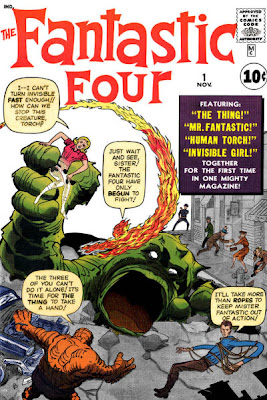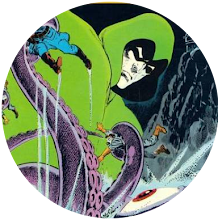Well, Steve Does Comics has never seen a kitten it couldn't hug, nor a bandwagon it couldn't leap on, so this is all the excuse I need to ramble on aimlessly about the book they called, "The World's Greatest Comic Magazine."
I first encountered the Fantastic Four in the pages of Amazing Spider-Man Annual #6 when they took on everyone's favourite web-headed wonder. What most impressed me about them was Reed Richards' ability to make his hands into giant ping pong paddles and the fact they didn't seek to make money from their powers.
My next encounter came in Mighty World of Marvel #4, in which we got the concluding part of their first battle with the Skrulls. Although I loved the Skrulls ending up thinking they were cattle, what most impressed me about that tale was I got the idea into my head that Benjamin J Grimm had three nostrils. From where I got this notion, I don't have a clue but it took many a long month of reading their adventures before I realised he didn't.
Other early highlights were their first encounter with Kurrgo: Master of Planet X, and their once having to be rescued from a crisis by Ant-Man, making Ant-Man officially the greatest hero in comics to my then tiny mind.
But it wasn't all plain sailing. Frankly, the Invisible Girl's uselessness in any crisis, leading to her getting kidnapped in what seemed like every issue, rankled with my youthful sensibilities so much I used to fill in her dots with a marker pen, so the bad guys could see her and kill her.
They never did.
But of course, despite all this, the strip hit its peak in the mid 1960s with the wedding of Reed and Sue and then that astonishing sequence of stories where they first met the Inhumans, met Galactus, met the Black Panther, met the Negative Zone, met the Kree and came up against a Cosmic-Powered Dr Doom.
As I roam the streets of Sheffield, no one whatsoever asks me what my favourite Fantastic Four tale is.
That won't stop me from telling everyone.
In hindsight, the tale made no sense at all, with the Inhumans failing miserably to work out whether they were trying to get away from or to the Great Refuge. It didn't matter. The madness of the tale just swept you along.
Sadly, as the 1960s entered their late afternoon, a fed-up Jack Kirby started to put less effort into things and the quality and freshness of stories tailed off noticeably. Ideas got recycled, sometimes from the comic itself, sometimes from movies and TV shows.
But still, even amongst such derivative stuff, there was The Prisoner-inspired tale of the FF trapped in Latveria, and the Thing being taken to another world to fight Torgo the robot. The roots of these stories might've been obvious but that didn't make them any less effective. And, as a Hammer Horror fan, how could I not love our heroes' first encounter with Agatha Harkness, their very own Mary Poppins?
Shortly after that period, I lost touch with the Fantastic Four, mostly because the UK reprints disappeared from the newsagents.
In the last reprint I read, Galactus was halfway through a fight with the Sphinx. I never did find out how that story ended.
But, despite my total ignorance of almost everything that's happened in the Fantastic Four since, I still retain my soft spot for them, the squabbling heroes who couldn't even muster a single secret identity between them. And if they each had their failings as human beings, I suppose that was what ultimately marked them out as human beings and therefore more interesting than the perfect heroes who'd preceded them.
Well, that's the bandwagon jumped on. All I need do now is find a kitten to hug.
But where will I find such a thing at this time of night?













































































7 comments:
Pssst...wanna buy a kitten?
It's OK. I've just eaten one.
"I never did find out how that story ended."
Galactus won.
Hooray! I always saw Galactus as a kindred spirit.
Mighty World of Marvel with Hulk, FF and DD, good times,
Simon
The true beginning of Marvel Comics. The FF, while not always the most popular Marvel property, is still the purest: co-created by the great team of Lee & Kirby, it features a teenage homage to Atlas's golden era; a hero who looked more like a monster; a super-team that also functions as a family unit; no costumes (Superman wears a costume - the FF wear UNIFORMS); and a female hero whose powers and appeal have continued to increase as the book carried on (thanks, Byrne!). This was my first Marvel purchase, and (during the 70's anyway), DC Comics always came across as George Lazenby over Marvel's Sean Connery!
Most of the main characters may have already existed decades before in earlier Timely and Atlas incarnations; and they may have been derived rather heavily from DC's (largely forgotten) Challengers Of The Unknown; still, The Fantastic Four in their heyday earned themselves an iconic place in popular culture. They were amongst the most realistic and believable of superheros--it was almost as if they and the Baxter Building actually existed somewhere in Manhattan. For most New Yorkers and serious rock fans, however, Sonic Youth probably took their place in pop mythology sometime around 1989.
Post a Comment